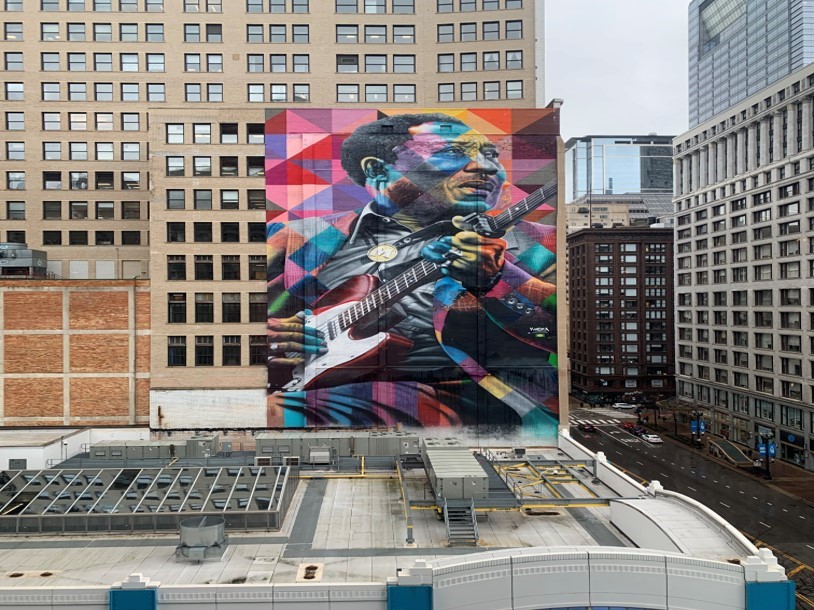
Meet Muddy Waters: King of the Chicago Blues
Published on February 27, 2023
In support of Black History Month, we’re pleased to feature Muddy Waters, one of the greatest blues musicians ever to come out of Chicago, and an important figure in the development of rock n’ roll.
By Dave Lifton (@daveeatschicago)
During the Great Migration, Black blues musicians who moved to Chicago had to adjust to their new surroundings. They had difficulties being heard in the noisy bars and crowded streets of the South and West Sides, so they bought electric guitars and played harmonica through microphones. The rhythms, influenced by the factories where the musicians had day jobs, became more precise and hard-hitting.
In short, Chicago is where the blues became electric. And nobody did it better, or was more influential, than Muddy Waters.

Photo by Dave Lifton
McKinley Morganfield was born in the mid-1910s in rural Mississippi, near its border with Louisiana and Arkansas. His mother died shortly after his birth, and he was raised by his grandmother on Stovall Plantation near Clarksdale, Miss. She gave him the nickname of “Muddy” due to his habit of playing near the river and coming home covered in mud, and he later added “Waters” for his professional name.
Inspired by the Delta blues of Charley Patton, Son House, and Robert Johnson, Morganfield began playing harmonica as a teenager and, by the age of 17, had purchased his first guitar. He cut his teeth in local juke joints and in Big Joe Williams’ band. In 1941, the famed folklorist/ethnomusicologist Alan Lomax gave Morganfield his recorded debut for a Library of Congress collection. Hearing the finished sides, for which he was paid $20, convinced the young bluesman that he was as good as anybody else out there. A year later, he cut some more sides for Lomax, and moved to Chicago shortly thereafter to pursue his dreams.
Settling on the South Side, he found work in a factory and as a delivery man, while building his name in the clubs. By 1946, Waters had an electric guitar and, after a few false starts, his big break came two years later, when he recorded “I Can’t Be Satisfied” and “I Feel Like Going Home” for the Aristocrat label. The record reached No. 11 on the R&B chart, and he continued recording for Aristocrat, who, by 1950, had morphed into Chess Records, named after the owners, Leonard and Phil Chess.
Over the next decade, Muddy Waters placed 14 songs in the Top 10 of the R&B chart, including “Long Distance Call,” “I’m Your Hoochie Coochie Man,” “I Just Want to Make Love to You,” and what would become his signature song, “Mannish Boy.” But his raw, aggressive sound didn’t cross over to a white audience in America the way that early rock n’ roll records by Fats Domino, Little Richard, and Waters’ future labelmate Chuck Berry did.
However, his records, and those by other Chicago blues musicians—including Howlin’ Wolf, Willie Dixon, Otis Rush, Koko Taylor, Little Walter, Junior Wells—gained an audience in England. Formed in 1962, the Rolling Stones took their name from the first single Waters recorded as a Chess artist. Over the next few years, the wave of British rock bands inspired by Waters and other Chicago blues acts included the Animals, the Yardbirds (whose guitarists included Eric Clapton, Jeff Beck, and Jimmy Page), and Them (whose lead singer was Van Morrison).
These and other English artists’ interpretations of Chicago blues helped introduce Muddy Waters’ music to white America and many—especially the Stones and Clapton—were quick to note Waters’ influence. Although he never achieved the level of fame as his disciples, Waters remained prolific and as successful as an adulterated blues act could be until his death of heart failure on April 30th, 1983.
During his career, Muddy Waters won six Grammys between 1972 and 1980 (a posthumous Lifetime Achievement Grammy came in 1992), and was inducted into the second-ever class of the Rock & Roll Hall of Fame in 1987.
His story continues to be told in Chicago. He has blocks named in his honor in Bronzeville and the Chicago suburb of Westmont, where he spent the last decade of his life. In 2016, Brazilian artist Eduardo Kobra’s 10-story mural of Waters with his 1958 red Fender Telecaster was erected in the Loop at the southeast corner of State and Washington. Four years later, the house at 4339 S. Lake Park Ave. in North Kenwood where he lived from 1954-73 was designated a city landmark, and his great-granddaughter is in the process of converting it into a museum with a recording studio in the basement.
“I’m hoping that this place will end up being a place [where] young people and old people, and lovers of the blues, and people who want to be educated about the blues will have an incredible safe haven to come,” Chandra Cooper said, “and to learn to listen and to just really understand who Muddy Waters was. And the legacy of who he is and the fact that he is the king of Chicago blues.”

The Adventure starts when you say it does.
All eATLAS Adventures are designed and built by experienced eATLAS Whoa!Guides. They're always on. Always entertaining. And always ready to go.
Check out our Adventures!